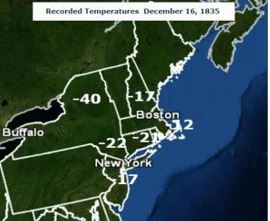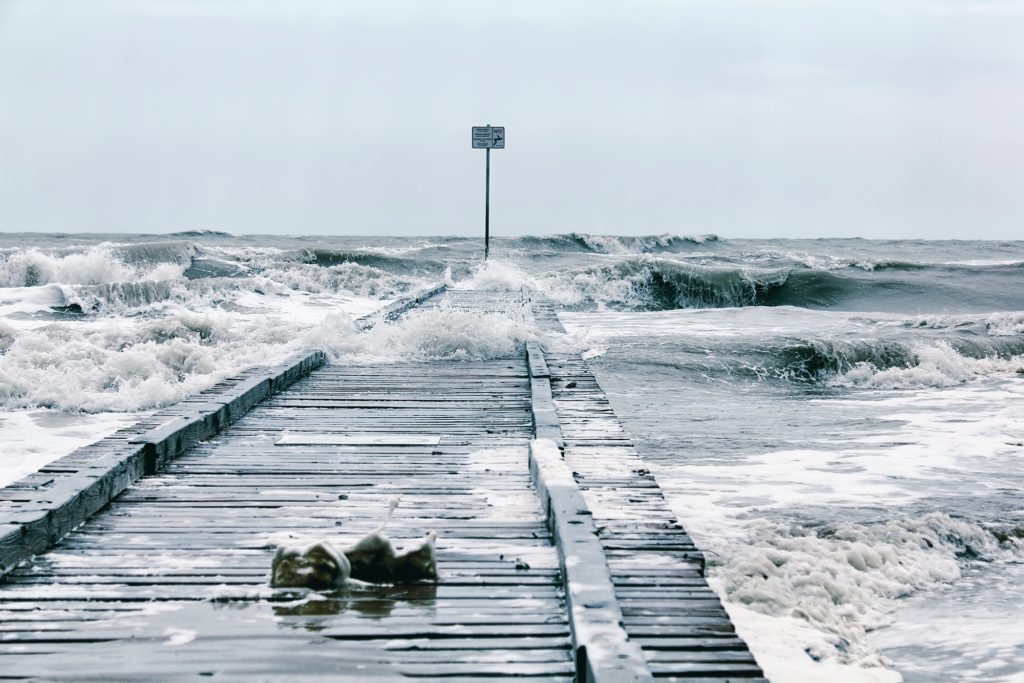This is a combination of two stories and they both depict extreme events with one having profound effect on the other. One was an intense cold outbreak in the Northeast. The other was a devastating fire that ravaged part of our nation’s largest city. From the early 1800’s, New York City insurance companies had always feared that there would be a destructive fire and unfortunately those fears came to fruition on a fateful December night.
City On Fire
December 16, 1835 was an extremely cold day in New York City which transitioned into an extremely cold evening. The temperature fell to a bone chilling 17 degrees below zero that night. At about 9 o’clock in the evening a gas pipe ruptured and came into contact with a coal furnace at a business in the “Cuentes Slip” section of Lower Manhattan between William Street and the East River. This interaction triggered a fire which became a raging inferno as is spread rapidly as to strong northwesterly winds rushed across the city.
Peter Holmes, who was an insurance company watchman discovered the blaze. Flammable materials in neighboring buildings helped to spread the fire.
The fire consumed building after building as is swept toward the East River. Over 1,500 volunteer firemen rushed to the scene with hand pumpers. Due to the extremely cold temperatures, the water in the attached hoses froze immediately and water that was pumped froze immediately. The firefighters were seen jumping on the hoses and pounding them with whatever they could find as they tried to break up the ice inside.
According to the New York Transcript, walls of buildings came crashing to the ground as the worn out firemen tried in vain to extinguish the fire. The fire was so intense that copper roofs on some buildings were melted and drops of copper actually fell to the street!
New York City residents who came to watch the fire gave credit to legendary Foreman Zophar Mills and Eagle Company 13 that controlled part of the blaze by piling tables and barrels to make a lift that they could climb to fight the fire.
A depiction of the Great New York City fire on the night of December 16, 1835 as seen from Brooklyn. Public Domain.
At 3 a.m. Mayor Lawrence Cornelius and Chief Engineer Lawrence Cornelius concocted a plan. Some men were sent to the Brooklyn Navy Yard to bring back gun powder in order to blow up buildings ahead of the fire.
In the meantime, chaos ruled the streets. According to an article in “Firehouse” merchants hired men to save what they could. Police chased thieves who were looting and around 400 were arrested. Vigilantes hung someone that they accused as an arsonist and the mayor had to call out the militia.
The fire burned out around 3 p.m. the next day (about 18 hours after it started) after the explosives were used. Fire departments from cities like Newark, New Jersey, and Philadelphia, Pennsylvania, were summoned to help extinguish hot spots.
All told, about 600 to 700 buildings in a 17- block were was totally destroyed. Damage was estimated to be around 20 million dollars, (over 630 million in 2025 dollars) ! Of the 26 insurance companies that were in New York City at the time, 23 went out of business. Fortunately, the fire occurred after workers had gone home so only two deaths were recorded. Insurance companies from Hartford, Connecticut then came in to insure businesses. There was plenty of political fallout with political parties pointed fingers. Chief Lawrence Cornelius lost his job as a result. Due to massive protests, he was later rehired.
This tragic event was the nation’s first major disaster and changed the way of life for New Yorkers and its firefighters.
Building codes were changed after the fire. Brick and stone buildings replaced wooden ones in the area. Changes in firefighting techniques took several years to become established. Finally, in the 1860s horse-drawn steam engines were used. A professional fire department was commissioned in 1865.
A photo showing a horse-drawn steam engine that was used to fight fires beginning in the 1860s. Credit-commons.wikipedia.org.
Meteorological Conditions
Unfortunately, there are no weather maps or “official” observations that go back to 1835. I did find some temperature records from the date of the fire. Obviously, it was extremely cold, one of the coldest outbreaks for the region in recorded history.
The map below shows low temperatures from some locations across the Northeast region on the night of the fire. It is no wonder that water froze in the hoses and on contact with materials. New York City dropped to -17 while Boston bottomed out at -12. The mercury fell to -22 at Poughkeepsie and -40 at Saranac Lake, New York.
A map showing recorded temperatures around the Northeast region on the night of the great New York City fire in December of 1835. Map Credit-Tom Moore.
There must have been a deep polar jet stream trough (dip) across the eastern U.S. allowing extremely cold air to come down from Canada. All areas upstream and back into Canada must have been ice and snow covered.
With the strong northwest wind reported, there must have been a passage of an arctic cold front prior to the event. There was likely an area of significant low pressure in the western Atlantic, as well. I wish that I could see the exact synoptic conditions.
Twenty First Century
Today, the FDNY is considered one of the best in the world. We know all too well about the bravery and dedication that these firefighters exhibit. Trucks that transport firefighters to the scene and the equipment that they use have changed dramatically since the 1800s.
A photo showing of FDNY responding to a call with modern equipment. Photo Credit- Wikimedia commons.
It’s also interesting to note that Hartford, Connecticut, became the “Insurance Capital” of the U.S. largely because of this tragic event.






